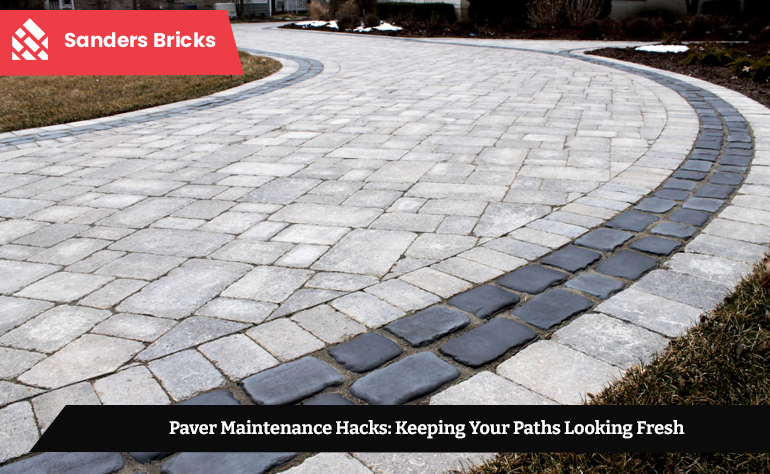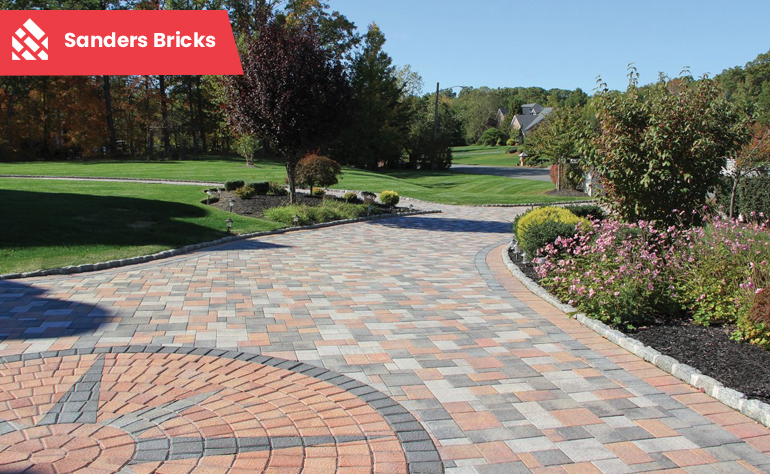Paver Maintenance Hacks: Keeping Your Paths Looking Fresh
Paver paths add a beautiful touch to any garden, driveway, or patio. They are durable, stylish, and can transform a simple walkway into a stunning feature. However, to maintain their appearance, you need to follow some paver maintenance tips. Over time, dirt, weeds, and weather can take a toll on your pavers, making them look worn and dull.The good news is that with a few simple maintenance hacks, you can keep your paver paths looking fresh and new for years to come. Whether you’re dealing with stubborn weeds, stains, or just want to keep your pavers clean and vibrant, these tips will help you maintain your paver paths with ease.
Regular Cleaning for a Fresh Look
One of the easiest paver maintenance tips is to clean your paver paths regularly. Regular cleaning removes dirt, leaves, and other debris that can make your pavers look dull. It also helps prevent the buildup of moss and algae, which can make pavers slippery and unsightly.
How to Clean Your Pavers
- Sweep Regularly: Start by sweeping your paver paths with a broom. This removes loose dirt, leaves, and small debris that can accumulate on the surface. Sweeping also helps prevent dirt from settling into the cracks between pavers.
- Wash with Water: Use a garden hose to wash down your paver paths. A strong spray can help remove stubborn dirt and grime. If your pavers are particularly dirty, you can use a pressure washer, but be careful not to use too much pressure, as this can damage the pavers.
- Soap and Water: For tougher stains, mix a little dish soap with water and scrub the pavers with a stiff brush. This is especially effective for removing grease, oil, or other stains that don’t come off with just water.
Simple Tips:
- Rinse Well: After scrubbing, be sure to rinse the pavers thoroughly with water to remove any soap residue. Leftover soap can attract dirt and cause more stains.
- Clean After Rain: After a heavy rain, give your pavers a quick sweep to remove any dirt or debris that might have been washed onto the path.
- Avoid Harsh Chemicals: Stick to mild soap and water when cleaning your pavers. Harsh chemicals can damage the surface and cause discoloration.
Weed Control to Keep Pavers Neat
Weeds can be a big problem for paver paths. They often grow in the cracks between pavers, making your path look messy and unkempt. Keeping weeds under control is key to maintaining the fresh appearance of your pavers.
How to Prevent and Remove Weeds
- Use a Weed Barrier: When laying new pavers, consider using a weed barrier fabric underneath the pavers. This helps prevent weeds from growing up through the cracks.
- Regular Weeding: Regularly pull out any weeds that start to grow between your pavers. It’s easier to remove weeds when they are small, before they have a chance to take root.
- Apply Weed Killer: For persistent weeds, you can use a weed killer. There are many environmentally friendly options available that won’t harm your plants or pets. Apply the weed killer directly to the weeds and avoid spraying it on your other plants.
Simple Tips:
- Fill Gaps with Sand: After removing weeds, fill the gaps between pavers with sand. This helps prevent new weeds from taking root and keeps your pavers stable.
- Boiling Water: Pouring boiling water over weeds is a simple, chemical-free way to kill them. The hot water will burn the weeds and kill them at the root.
- Vinegar Solution: Mix white vinegar with water and spray it on the weeds. This natural solution is effective at killing weeds without using harsh chemicals.
Seal Your Pavers for Long-Lasting Protection
Sealing your pavers is one of the best ways to protect them from stains, weather, and wear. A good sealant can keep your pavers looking fresh and new by creating a protective barrier on the surface.
How to Seal Your Pavers
- Choose the Right Sealant: There are different types of sealants available, so choose one that’s suitable for your pavers. Some sealants enhance the color of the pavers, while others provide a more natural finish. Make sure the sealant you choose is weather-resistant and designed for outdoor use.
- Clean Before Sealing: Before applying the sealant, make sure your pavers are clean and dry. Any dirt, dust, or stains on the surface will be sealed in, so it’s important to start with a clean slate.
- Apply Evenly: Use a roller or sprayer to apply the sealant evenly across the paver surface. Be careful not to apply too much at once, as this can cause pooling and uneven coverage. Apply two coats for the best protection, allowing the first coat to dry before applying the second.
Simple Tips:
- Reapply as Needed: Depending on the type of sealant, you may need to reapply it every few years. This will ensure your pavers remain protected and looking their best.
- Test First: Before sealing the entire path, test the sealant on a small, inconspicuous area to make sure you’re happy with the finish.
- Avoid Sealing in Extreme Weather: Don’t apply sealant on very hot or very cold days. Extreme temperatures can affect how the sealant dries and adheres to the pavers.
Fixing Cracks and Loose Pavers
Over time, your paver paths may develop cracks or have pavers that become loose. These issues can not only make your path look less attractive but can also be a tripping hazard. Fixing these problems as soon as they appear will keep your paver paths looking neat and safe.
How to Repair Cracks and Loose Pavers
- Fill Small Cracks: For small cracks in the pavers, use a paver crack filler. This is a flexible material that can be applied directly into the cracks to seal them and prevent them from getting worse. Once applied, smooth the surface with a putty knife and allow it to dry.
- Replace Damaged Pavers: If a paver is cracked or broken beyond repair, it’s best to replace it. Carefully remove the damaged paver, clean out the space, and place a new paver in its place. Make sure the new paver is level with the surrounding pavers.
- Re-Level Loose Pavers: If a paver has become loose or sunken, you can fix it by re-leveling the base. Remove the loose paver, add or remove sand from the base as needed, and then replace the paver, ensuring it is level with the others.
Simple Tips:
- Check Regularly: Make a habit of checking your paver paths for cracks or loose pavers every few months. Early detection makes repairs easier.
- Keep Extra Pavers: When you install a new paver path, keep some extra pavers on hand. This way, if a paver gets damaged in the future, you’ll have a matching replacement ready.
- Compact the Base: When fixing loose pavers, make sure to compact the sand base well. This will help prevent the paver from becoming loose again.
Dealing with Stains on Pavers
Stains are inevitable, especially if your paver paths are in high-traffic areas or near outdoor dining spaces. From food spills to oil leaks, stains can make your pavers look dirty and old. However, with the right paver maintenance tips, you can remove stains effectively and keep your pavers looking fresh.
How to Remove Stains from Pavers
- Oil and Grease Stains: For oil and grease stains, sprinkle some baking soda or cornstarch on the stain to absorb the oil. Let it sit for a few hours, then scrub it with a brush and rinse with water.
- Food and Beverage Stains: For stains from food or drinks, a mixture of dish soap and water is often enough to remove them. Scrub the area with a stiff brush and rinse with water.
- Rust Stains: Rust stains can be a bit tougher to remove. Use a rust remover that’s safe for pavers and follow the instructions carefully. Be sure to rinse the area well after cleaning.
Simple Tips:
- Act Quickly: The sooner you tackle a stain, the easier it will be to remove. Try to clean up spills as soon as they happen.
- Test Cleaners First: Before using any cleaner on your pavers, test it on a small, hidden area to make sure it won’t discolor or damage the pavers.
- Seal for Stain Prevention: Sealing your pavers can help prevent stains from setting in. A good sealant will make it easier to clean up spills and keep your pavers looking fresh.
Maintaining the Joint Sand
The sand between your pavers, known as joint sand, plays an important role in keeping your paver path stable and looking neat. Over time, joint sand can wash away or become compacted, leading to loose pavers and weed growth. Keeping the joint sand in good condition is key to maintaining your paver paths.
How to Maintain Joint Sand
- Reapply Sand as Needed: If you notice that the sand between your pavers is thinning or has washed away, it’s time to reapply it. Use polymeric sand, which hardens when wet, to fill the joints. Sweep the sand into the joints and lightly mist with water to set it.
- Compact the Sand: After reapplying sand, compact it by running a plate compactor over the surface. This helps settle the sand into the joints and prevents it from washing away.
- Seal the Joints: Sealing the joints can help keep the sand in place and prevent weeds from growing. Use a joint stabilizing sealer that’s designed to work with polymeric sand.
Simple Tips:
- Sweep Regularly: Regularly sweep your paver paths to keep the joint sand in place and prevent it from washing away.
- Add Sand After Heavy Rain: Check your pavers after heavy rain and add more sand if needed. Rain can wash away the joint sand, leaving your pavers less stable.
- Watch for Weed Growth: If you notice weeds starting to grow between your pavers, it may be a sign that the joint sand needs to be topped up.
Conclusion
Keeping your paver paths looking fresh and well-maintained doesn’t have to be difficult. By following essential paver maintenance tips like regular cleaning, weed control, sealing, and timely repairs, your pavers can stay in great shape for years. These maintenance hacks ensure beautiful, clean, and safe paver paths that enhance your home and garden. Whether dealing with weeds, stains, or loose pavers, a little care and attention can keep your paths looking as good as new.

